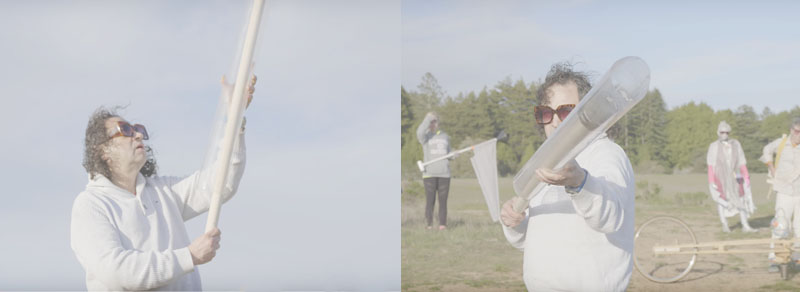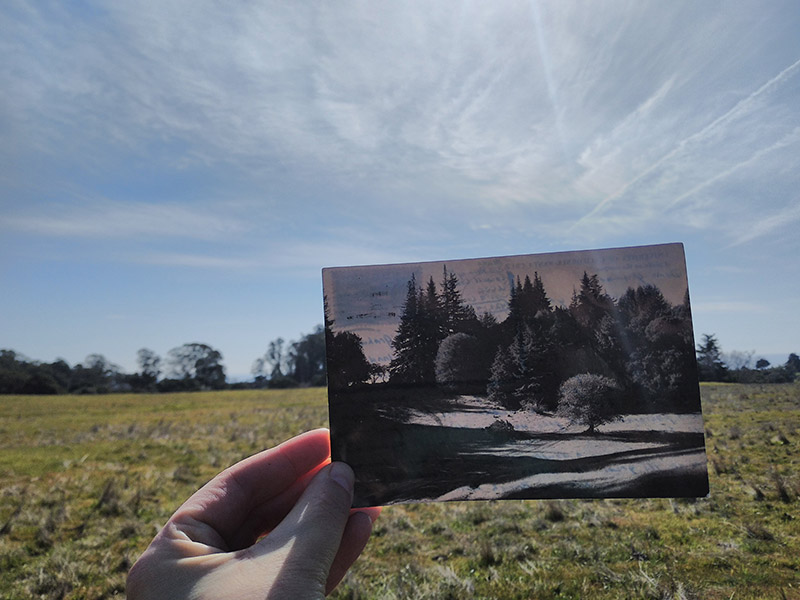Leila Kaplan and Embodied Ecology: A comedy about acorn woodpeckers in the foggy oak woodlands of
Pogonip. Photo by Jin Zhu |
"Calling all humans, animals, bio and trans, men and women, transgender bodies, mutants, voices and survivors. You are invited by Futurefarmers, Beth Stephens & Annie Sprinkl •e to celebrate the leap year of love and together, form •a liquid community to marry the Fog!" These were the words of inviation for Fog Wedding: A Re-eroticism of the Universe initiated by Futurefarmers and Elizabeth Stephens and Annie Sprinkle of the E.A.R.T.H. Lab
A fog of bodies rolled in from the coast, tumbling onto the Great Meadow, a gathering site for two lines of force within radical feminist art where ecosex is enacted and medico-judicial categories of sexuality (homosexuality / heterosexuality) are troubled. Among an assembly of humans and animals, bio and trans, men and women, transgender bodies, mutants survivors, witnesses, ring bearers... Beth Stephens and Annie Sprinkles initiate a ceremonial bond to the fog – together a re-eroticism of the universe, a calling into question the hierarchy of species, definitions of sexuality, and the political stratification of the body.
On this day, 80 people married the FOG, each with a curious accoutrement or sculptural appendage; fog catchers, a bench for the warry, a dozen fog horns, a whistling tea kettle, song lyrics and more. A taxidermied mountain lion poised upon a bier and a table of lichen were carried along as witnesses to this special fog event. An "ecosexy woodpecker performance", sound art, Uni sang a song in Chinese, and seeds were spread along the path. A day to remember. At the reception was cake, bouquet toss and 1:1 scale oragami, and Lady Monster wore a fog costume and gave lap dances. We will never see fog the same way again. But as a partner/collaborator/beautiful-bitch/mysterious lover...
Guillermo Galindo honored us with a marriage counseling piece.
 |
| Marriage Counseling: Guillermo Galindo. Photo by Jin Zhu |
"Important: Wear Grey on top layer and a solid color underneath, " were the instructions on the invitation to the Fog Wedding. As the sun set into the horizon and the fog rolled in, the procession of bodies peeled off their top layers of grey and blossomed into a colorful, prismatic happening.
Before lowering our coloful bodies into the infamous sinkholes, a suite of fog horsn fashioned fom pvc pipes and funnels accompanied these these words:
"We wish to acknowledge the students, the faculty, the service workers, the tax-payers, the non-humans, the air, the ocean, those who dwelled on this land before us, the soil beneath our feet and especially the coastal fog. On this leap day of leap year, we dedicate this wedding to those who have been part of the struggle to protect and define a truly just and public education. We see this act of marriage as a counter-space, a shared moment to acknowledge the local, physical phenomena of fog and its possibility to mystify, transform, disolve and reappear." |

